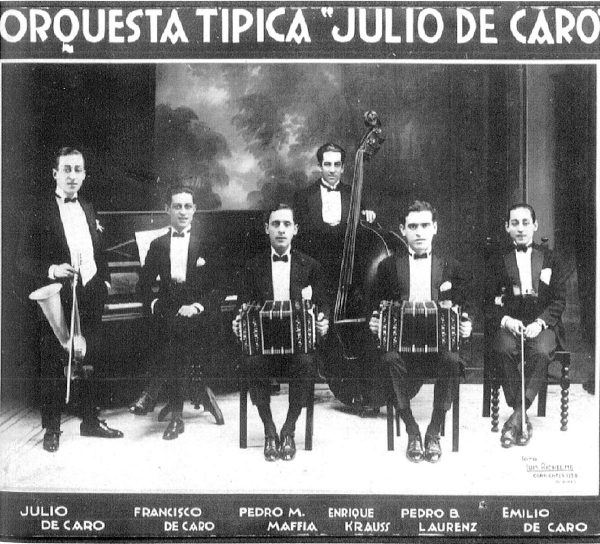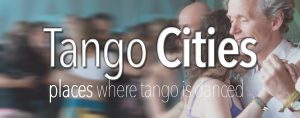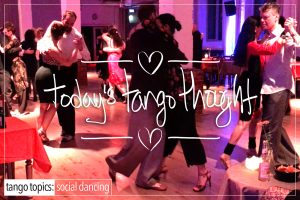At nearly every Milonga in the world that you’ll attend there are a handful of songs that have very specific meanings. One of them is played at the end of the night to signify that the Milonga has come to end, which should be a cue to find your favorite partner and to dance with them. The song? Por supuesto es, “La Cumparsita” or as it is translated into English, ‘The Little Carnival’. To be fair (mostly so that I don’t get hate mail or to come off as being inaccurate), not every Tango DJ will play “La Cumparsita”, a good portion of them rebel against this common Tango trend and for several good reasons, not the least of which is that it’s overplayed.
Tango DJ’s aside, nearly every major Tango orchestra has recorded a version of this song, with the exception of Demare, Malerba, and Carabelli. That last one is a little strange because Carabelli was the orchestral lead for another Tango Orchestra > Orquesta Tipica Victor. RCA Victor’s ‘house’ orchestra. While the members of the house orchestra changed at Carabelli’s whim, and he had ample access to record whatever he wanted, whenever he wanted, he never recorded a version of “La Cumparsita” for his own orchestra. OTV recorded it twice (1926 & 1932), but Carabelli? Nope.
Of the Twenty-One orchestras that are represented here (minus Firpo), there are some odd factoids that may stand out to you. Like for instance, you would think that Canaro being Mr. Prolific Tango would have the most versions of La Cumparsita (7). He doesn’t. That honor goes to El Rey Del Compás, Juan D’Arienzo with 8! And pulling up the rear is Anibal Troilo with 6 versions. D’Arienzo’s protege, Biagi ? Just 4. Roberto Firpo, who is credited (read below) with starting the trend before it died out soon after, only has 3 (1916, 1928, and 1937) to his credit. Nearly every version has some twist on it that makes it uniquely the orchestra that recorded it, but the versions all sound nearly the same, with some very interesting variations. However, the strangest version comes from exactly who you’d think it would be, Astor Piazzolla who recorded a version in 1966 adhering to his idea of ‘Nuevo Tango’ (new tango), which sounds absolutely nothing like what you’d expect “La Cumpasita” to sound like! Yet, prior to his founding of Nuevo Tango in 1960 in Paris, he did record a version in 1955 that was very ‘traditional’. Don Pugliese, another Piazzolla convert, did 3 versions in his life (1959, 1965, and 1989 respectively), the earlier version is traditional with (sort of, but you can hear he’s about to go off the musical deep-end) and the last two DO go right off the proverbial deep-end, why? You can thank his buddy Piazzolla for that one!
What’s the most common or popular version that is played at nearly every Milonga? Answer: That honor goes to the Di Sarli ‘55 version which is sort of a remix, it’s the one that has the most echo and reverb. Why ? Because the record company wanted to make the orchestra sound more full, bigger than it actually was. This was also the trend of the day, so a lot of recording engineers did the same thing, during the same time period. It was a trend. There isn’t, unfortunately to our knowledge a clean version of this recording today that survives. Sadly. 🙁 The next more common version is the D’Arienzo ’63 version. It is unique for one reason, it has ‘stops’, actual Musical stops which make it somewhat interesting to dance to. It’s ‘dramatic’ without it being overly sappy and syrupy in the the late 50’s and early 60’s is just that, IMO. Truthfully any version of La Cumparsita can be modified with a little sound editing to add ‘stops’, like El Rey de Compas Don D’Arienzo. We modified the D’Arienzo version to extend those ‘stops’ a little bit more to make them even more pronounced:

A few more interesting facts, even though Firpo wrote lyrics for La Cumparsita, it was only recorded 4 times with a singer, and only once with a woman. D’Arienzo recorded it twice with a singer, once with Carlos Dante in 1928 and then later with Raquel Notar! Pedro Laurenz only recorded it once in 1953. However, 23 years earlier, when he was working with El Orquesta Tipica Julio De Caro (Julio, Emilio, and Francisco), he took off and tore up the town with legendary Bandonista Pedro Maffia. They recorded a version in 1926.

These are just some of the interesting factoids of this song that is so ubiquitous that is played at every milonga in the world, and there are a host more. Actually, truth be told, most of Tango music is like this. Each orchestra has their own take on a song, a rendition, which was later recorded and then played out. While there are hosts of versions of a song, there are very few actual different recordings. Meaning ? That if you take a look at a library of tango music, that there are loads of copies of the same song that all come from the same source. However, there are even fewer variations, which this page (hopefully) has detailed and gotten right. It may have missed one or two, but then again, if you want accuracy there’s no time like the present to start your music study and history lesson! Because it is a history lesson and a musical study at the same time. And what a wild ride it is. Yes it’s overwhelming, but that’s where the fun is at. Truthfully. Taken a piece at a time, it can be quite an interesting exploration, an opportunity to go deeper with this dance that we love.
Below today’s little history lesson you’ll find a listing of 18 of the 22 orchestras with a 15 second snippet of the sound of each Cumparsita, go take a listen and then consider purchasing a Gold+ subscription to Tango Topics where you can listen to most if not all of this stuff in it’s entirety!


















From the Tango Truisms Archive: A Little History of “La Cumparsita”
Once upon a time there was a young architectural student named “Becho” who in 1916 wrote a carnival march called “The Little Carnival”. His father, happened to own one of Uruguay’s more popular night clubs, and through a friend ended up showing the music to Maestro Roberto Firpo who was working at the club. Firpo saw the piece and was determined to turn it into a Tango. From his perspective he was given the music to polish up because “Becho” needed it that night. So polish it he did, he tweaked, changed, modified, and he added a few things here and there. He presented it that night as “Becho’s” work, but in November of that same year Firpo recorded the song for Odeon Records: Odeon release number 483. It got a little bit of play but it essentially died after that. Years later a version of the song was recorded, with Lyrics this time, and it became a huge hit, under the title “Si Supieras” (If you knew). “Becho” was Living in Paris at the time when he went and talked to his Uruguayan friend and musician Francisco Canaro. Canaro said it was all the rage! Over the next 2 decades Gerardo Hernn “Becho” Matos Rodrguez fought to retain the rights of his creation. It was only through Canaro’s SADAIC in 1948 that a binding deal was brokered where “Becho” got some of his due (about 20%). The song you all know, have heard a thousand and one times at this point, and danced at every milonga to is “La Cumpasita”, The Little Carnival.










